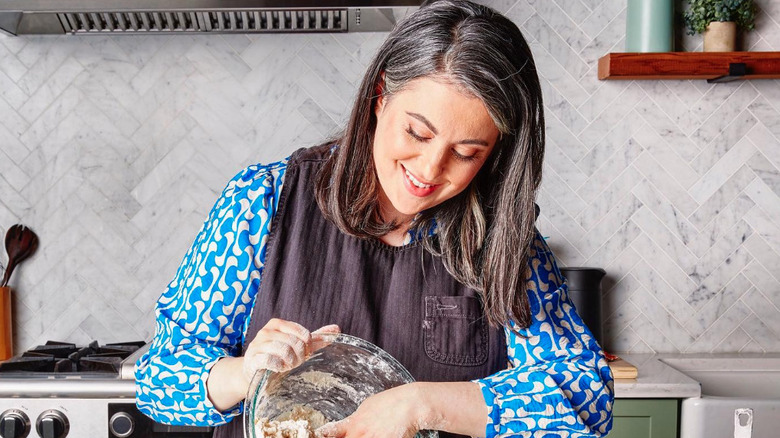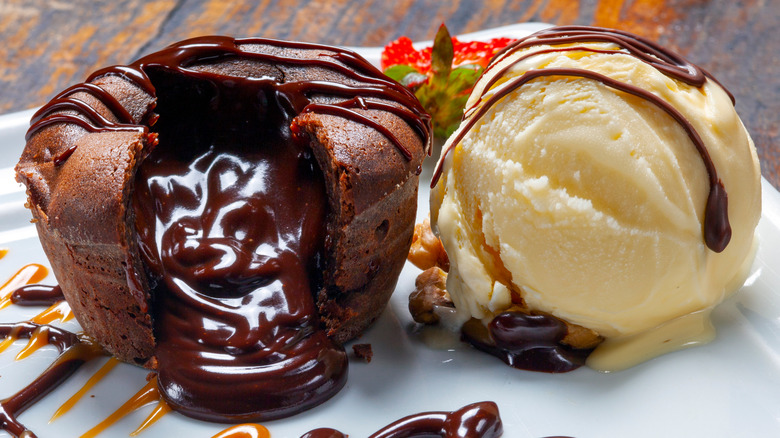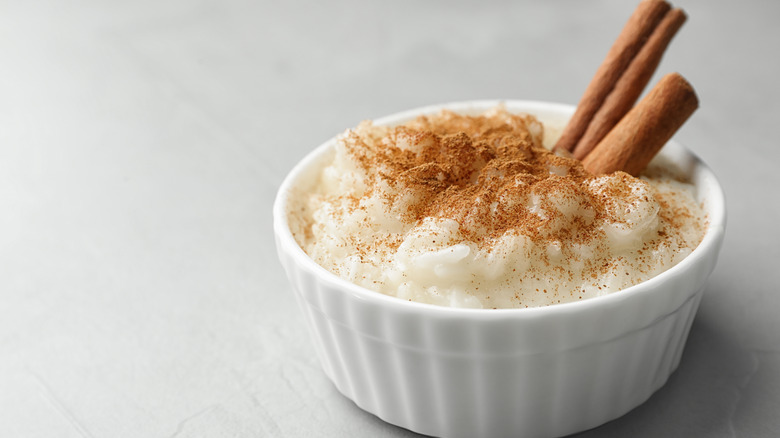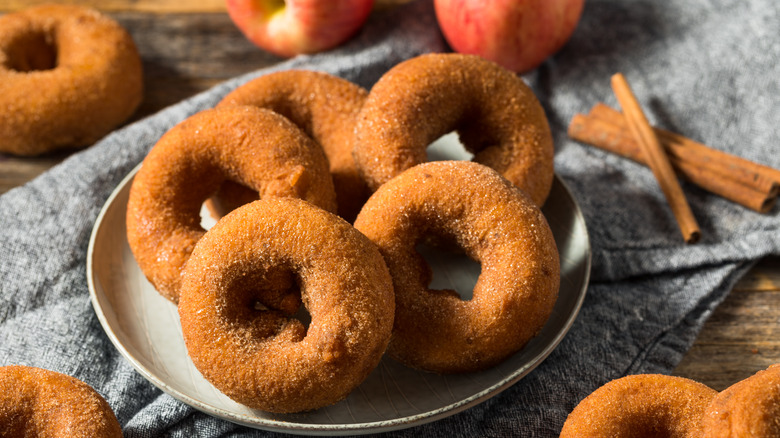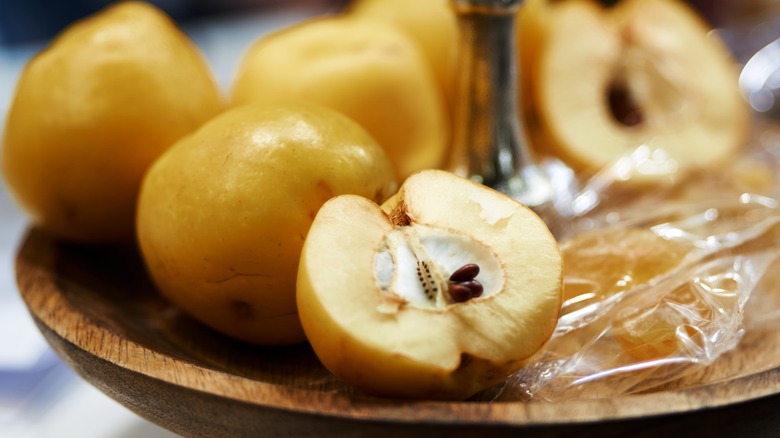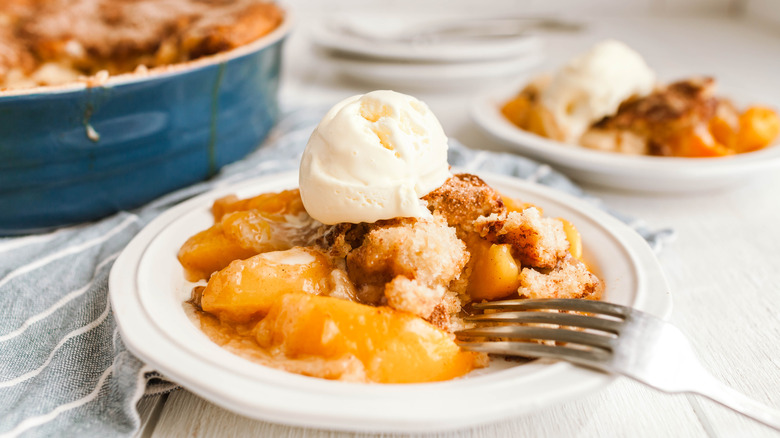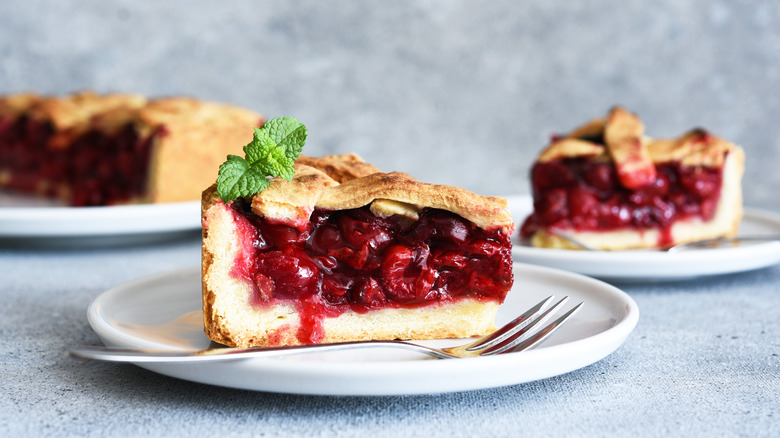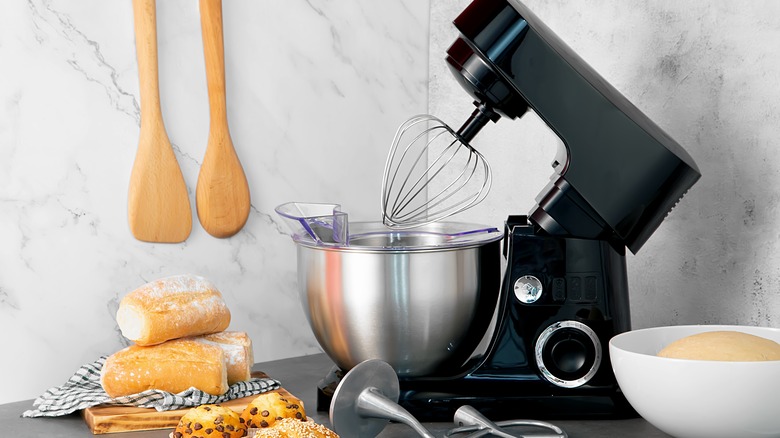Claire Saffitz On What's For Dessert: Simple Recipes For Dessert People - Exclusive Interview
Claire Saffitz is all about the sweeter things in life. As a chef and dessert cookbook author, she loves perfecting deliciously sweet recipes — you may even have seen her whip up a confetti cake or blueberry pie on her YouTube channel, "Desert Person with Claire Saffitz." In her upcoming book, "What's for Dessert: Simple Recipes for Dessert People," she shares just how easy baking can be, no matter your skill level or the equipment you have (or don't have) in your kitchen.
During an exclusive interview with Tasting Table, Claire Saffitz told us all about "What's for Dessert: Simple Recipes for Dessert People," her favorite fall fruits to bake with, and why she's not a big fan of apple cider donuts. She also chatted about why it's so important for her to show how simple baking can be and why she doesn't believe you need any of the popular fancy equipment to do it.
She wants to make baking easy for everyone
Congrats on your new book, "What's for Dessert," coming out. What are you most excited to share with your audience with this new book?
I'm excited for people to experience the accessibility of the recipes. "Dessert Person" was so much about my own point of view as a baker, and everything is baked, so there's a lot of technique involved, and some of the recipes are fairly elaborate. I used a lot of feedback from "Dessert Person" to shape this book.
What I heard — which is not that surprising — was that people wanted more streamlined, simple stuff. I feel like I delivered with this book. In some ways, it made it a lot more challenging to develop these recipes. It's hard to do simple stuff and to produce that volume of streamlined recipes. I pushed myself a lot to foreground accessibility and approachability in the recipes. You don't need a stand mixer for any of them; a lot of them are completely makeable entirely by hand.
I'm excited for people to see there's a lot that you can accomplish with less equipment and [fewer] specialty ingredients. The ingredients are also pretty accessible. There's very few specialty things that one would have to source from a place other than a big grocery store.
Her tips for a chocolatey favorite
Molten lava cakes seem pretty hard to master. Do you have any tips to make this dessert?
I had never made it before, but it felt like the recipe I wanted to include in the book because it feels fancy and super celebratory. I was doing a lot of research, and I realized it's not as complicated as you might think. I knew it couldn't be that complicated because it's now such an ubiquitous menu item. Domino's Pizza has a molten lava cake, so I was like, "How hard could it be?"
It was fun to develop it. There's a number of different approaches, but the approach that I take is to basically make an eggy, very low-flour batter that doesn't quite set in the middle. The key is not baking it too much. The batter is easy to put together.
The key is two things — it's greasing the molds really well. Even though the recipe uses olive oil as the fat rather than butter, you do grease the molds with butter, because you need a fat that is solid at room temp so that you can get a nice thick layer on it. Beyond greasing the molds well so that you can get them out, it's keeping a close eye on them as they bake and paying close attention to the indicators. Whether [you're] baking in a metal mold or in a ramekin, it's paying close attention to the indicators and making sure you don't overcook them so that you get the molten center.
The other key is getting them served on the plates and serving them very quickly because they will set up a little bit. Having someone help you unmold them if you're serving all eight at once is also key.
It's a somewhat straightforward recipe, and I want people to realize from the book that some things they thought were hard are a little bit easier than they thought.
She loves playing around with flavors and textures
Many people also love a mix of salt and sweet with their desserts, such as with your Caramel Peanut Popcorn Bars. What are your favorite unexpected sweet and savory combos?
I love incorporating savory flavors into my baking. One of the recipes I love in the book is this banana sesame cream tart. People are accustomed to the combination of banana and sesame now, but rather than using tahini, which would be the first thing I would think of when I hear banana and sesame, it's toasted sesame oil. There's a pungent bitterness to it. I love that. That's a great sweet-savory combination. It works so well. It's a lovely spin on a banana dessert.
I love baking with nuts. Oats and walnuts both come alive when you add a lot of salt. All my recipes are well seasoned and have a good amount of salt to bring out the flavor, because salt is a flavor enhancer just like sugar is. A lot of the work in the book when I'm recipe developing is balancing the sweet and the salty so that the recipe tastes like the most vibrant version of itself.
The flavor is all about balance. Dessert should be sweet, but it should be not too sweet — and those sweet flavors should be balanced out with other flavors like bitter, salty, acid, [like] using a bright lemon zest to brighten something up. All of these things are going to enhance the flavor and create great balance.
Do you have any tips to upgrade your average rice pudding?
I happen to love rice pudding because it feels like the ultimate comfort dessert. I don't like to do a lot with it. The upgrades for rice pudding are about using a high-quality rice to start — a carnaroli or an arborio — something that's going to release a lot of starch but retain its shape even when it's tender. Sometimes when I eat rice pudding, it's a little underdone, especially if it's served cold. When something's hot, it's softer than when it's chilled. Sometimes when you think it's done and then you chill it down, you realize there's a little bit of a bite to it. It should be fully cooked.
Using high-quality dairy and some vanilla bean is all you need for rice pudding, and seasoning it with a good amount of salt to bring out and balance out the flavors. That's how I like my rice pudding — super creamy and full of dairy. I love milky flavors and lactic flavors and a little bit of tang. If you're using high-quality vanilla, that brings so much flavor to the dish.
Once you have that base, you can play around with topping it with seasonal fruit, like a compote. Even though I don't think about rice pudding as a summer dessert, you could do a blueberry compote or macerated strawberries, or if you're making a less sweet rice pudding, a little dollop of high-quality jam. Roasted plums or stone fruit [are] really nice.
It is a bit of a heavier dessert. Balancing it out with some seasonal fruit that's bright and brings in a different texture is nice. Toasted nuts can also bring a crunch, because the dish is not exactly a multi-textured dish. It's very soft, which is what I like about it, but it's nice to have a little crunch in there.
You won't catch her making apple cider donuts
Now that we are in the fall season, are you big into using pumpkin or any other squash in your baking?
I love baking with squash. When it comes to pumpkin, I pretty much use the stuff from the can. It's high quality, [and] it's very concentrated so it has a lower water content.
As far as other types of squash, I do love baking with kabocha squash. That's such a flavorful and beautiful and low-water-content squash. The flesh is pretty starchy, so it is great in pies or custards, where that starch helps to set everything nicely. I love the toasty orange color of it that it brings.
You can roast the entire thing whole. You literally stick the entire thing in the oven — no peeling or anything. It steams from the inside out, and [you can] scoop out the flesh. It makes a wonderful base for pie.
What about fall spices? Do you have one that you love using all the time when baking?
I bake a lot with warm spices. In fact, I have to often edit myself to not put cinnamon in everything. I do love cardamom. I love the almost citrusy but also warmth that it brings to a recipe, although you have to be careful not to overwhelm with it.
I also like to bake with spices that we think of as being a little more savory. Ground coriander is lovely in desserts and reads like a warm spice. But I do love cinnamon. It has to be a high-quality cinnamon. I bake a lot with regular supermarket spices, including ground cinnamon, but when you get your hands on some high-quality — like Vietnamese cinnamon — it is a world of difference. It brings so much spiciness to the dish.
Black pepper can be an interesting baking spice. I have a little bit of black pepper in a cookie recipe in "Dessert Person" that adds a nice spiciness. Of course, the tiniest pinch of ground clove makes everything taste like it's perfect for the holidays.
Are there any fall desserts that you feel are very overrated?
I'm not a huge fan of the apple cider donut thing. It's mostly because people go crazy for it. It's not what I think of when I think of fall desserts that I want to eat. That one is a trend that I'm a little skeptical of. The excitement tends to be more about the apple-picking season than it is about the actual food itself, because I'm not so sure that it's as deserving of all the praise that gets heaped on it.
But I do generally love fall baking. I get excited when the weather gets a little bit cooler and the apples come into the market and the pears and everything.
She's a big fan of using apples and quince for baking
Which apples do you think are best for baking, and which ones aren't?
In my experience as far as a supermarket apple that is easy to find, Pink Ladies do really well. They hold up great in the oven. They don't break down into apple sauce; they don't get mushy. They have a nice, concentrated, sweet-tart flavor and good balance.
Honeycrisps are also good. They retain their shape and they have good flavor, but their flavor is a little bit diluted. They're very juicy, so the flavor isn't as concentrated.
I'm in the Northeast with so many different kinds of farmer's market apples that you find, because there's hundreds if not thousands of varieties. The one that I look for later in the season in November is Gold Rush, which is an incredibly flavorful apple. It is so crisp and so firm that if you eat it out of hand, it actually almost hurts your mouth.
For baking, you want an apple that's firm, not mealy, that has good sweet-tart balance and that won't break down in the oven.
I wouldn't use Golden Delicious. Sometimes, those are called for as a baking apple, but I've never found those to hold up very well. This is a test that I have for apples: You put the whole thing in your hand, grip your palm around it, and you try to press your thumb into the flesh. If you can easily make an indentation, then that's not a good baking apple. That means it's going to break down.
Besides apples, do you have any other fall fruits that you love to use in your baking recipes?
I love quince — not something that is widely available. It grows well in the Northeast; I know they have them in California and in other parts of the country. It's definitely a farmer's market thing. They are the most incredible fruit. That's my favorite fruit to bake with.
It's a very ancient fruit. It's been around for so long. When you bring home ripe quince, they perfume your entire kitchen. It smells like a pineapple mixed with a pear. You have to cook it for it to be palatable because it's very astringent when it's raw. Often, they're poached or roasted or cooked down into a jam or compote.
The biggest mistakes people make when baking cobbler
I love a good cobbler, but there's got to be several mistakes in making them. What do you think is the biggest mistake someone can make when baking a cobbler?
I worked hard on the cobbler in the book because it was not something I make all that often. I'm more likely to make pie than cobbler. I had to troubleshoot quite a bit, because I was running into issues with cobbler. I was doing a biscuit-topped cobbler. There's many different variations on cobbler, but that's what I think of when I think of cobbler. It's a biscuit topping over fruit.
I kept finding that the bottom of the biscuit topping was staying undercooked and staying doughy and unappealing. Starting with a hot filling was counterintuitive because I think of biscuits as being something you want to keep cold, and to put it on a hot filling felt very counterintuitive to me. But it does help to bake the biscuits full, from the bottom up as well as from the top down. It is a bit tricky and almost technical in that sense. We think of it as being an easy dessert, but like so many things, what's simple or easy can also be quite precise at the same time.
[Another] mistake people make with cobbler is adding too much thickener to the filling so that you're getting something that is a little bit starchy where it should be juicy, and you're tasting the starch. Anything with a fruit filling that's starch-laden, you have to bake for quite a long time so that it basically comes up to a boiling point. If you're using corn starch or whatever it is, that's having a chance to thicken everything.
It is about balancing the bake times with the filling and the biscuit topping and everything. I often like to pre-cook a fruit filling, which does add a step, but it does enhance the final result quite a bit.
Her trick to the perfect pie crust
You said you would normally make pies over cobblers. Do you have any pie crust hacks to share?
I'm so proud of the pie crust recipe in "What's for Dessert." It represents a culmination of my many years of making pie dough at home and trying to come up with the best method.
The recipe does not change. It's a very set proportion of ingredients, and there's very few ingredients. To call it a recipe is almost not accurate — it's about the method. The method in the book is so forgiving and friendly to beginners that I'm excited about it.
What's tricky about pie dough for people is getting the hydration right. It's common knowledge that, yes, you have to keep everything cold, and you want the butter to be in pieces, but it's really about nailing the hydration. I've found in all of my recipe testing that you want a drier pie because that is going to be the most tender. The less water you add, the less gluten development you have. It's going to hold its shape, and it's going to bake up flaky. That's tricky because if you underhydrate it, it can crack when you roll it out, and it makes it a little more difficult.
The method in the book involves taking big pieces of butter. You loosely break them up in the beginning. You add the water; you stir it in. Rather than trying to bring everything together in a bowl, you dump everything out onto your countertop. Use a bench scraper or a bowl scraper or any straight edge, and you chop it up on the surface. Then you toss everything together.
Chopping it up, you're not using your hands, so you're not warming up the butter. Two, you are not really working it, so you're not developing a lot of gluten. Three, you are constantly bringing the mixture together in a way that evens out the hydration and breaks up the butter into different size pieces. Then you bring it together, cut it into pieces, and stack it to increase the flakiness and give it a little bit of structure.
I wouldn't call it a hack because you're still making in the same process and basic order of operations, but the method allows so much flexibility.
Fancy equipment you don't need when baking (and unexpected gadgets to use instead)
Your new cookbook doesn't call for a lot of fancy equipment. Is there one piece of equipment that a baker doesn't need?
There's many, actually. There are a lot of single-use tools that I don't find to be necessary. I don't think you need a blender ... When you're making dessert or doing pastry, an immersion blender is great, and it's so convenient because you're often trying to blend something that's already in a bowl or a saucepan or something. I don't think that you need a high-powered blender. I have a Vitamix at home, but I don't use it that often. I will only use it for smoothies, but not in pastry and baking because an immersion blender is more than sufficient.
The whole book was developed with a hand mixer and not a stand mixer. I don't get out my stand mixer very often. There's certain things you have to use it for [when] there's no way to achieve the thing you want to achieve by hand, but that's relatively rare. I don't think it's a necessary item. That's more of a luxury item, and that's why the book doesn't require it.
I don't use a lot of individual molds. I don't think that those are necessary. Ramekins are great. Custard cups are great. Those are convenient and inexpensive. I don't think you need fancy molds to make most desserts. I did inherit a big tin of all of these wonderful, fancy French molds, but I never use them and they're on a shelf way up high, so I never get them out.
Are there any underrated kitchen gadgets that new bakers don't realize they should be using?
It's not really a gadget, but I use a ruler and tape constantly in the kitchen. I keep a ruler in my crock with my other big utensils, and I pull it out all the time. It's tempting to think of it as being fussy, but it's actually convenient to be able to measure things quickly.
There's a lot of things that [are] a bridge between kitchen gadgets and other hardware store gadgets. A palette knife can be weirdly helpful for frosting a cake or applying a thin layer of something.
There's inexpensive, easy-to-find things that are maybe not on people's radar like a bowl scraper — a $1 or $2 piece of flexible plastic that is so convenient and helpful for me. I pull it out all the time. Add that to your drawer of mixed tools because that will come in handy, and it might surprise you that you use it as much as you do.
"What's for Dessert: Simple Recipes for Dessert People" is in stores November 8. See what else Claire Saffitz is baking by following her on Instagram.
This interview was edited for clarity.

